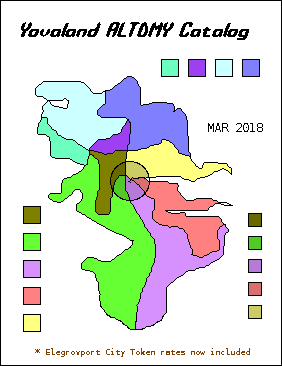Example fictional publication

Collections of investment grade lease tokens could be repackaged where legal as a single average spanning index set of a more so universal type of token as an Average Lease Token Decimeter Year (ALTDMY) token, or likewise where fractional measuring is prevalent perhaps formulated as Average Lease Token Hundredth Yard Year (ALTHYY), or perhaps most intuitive and best might be Average Foot Month (AFM).
Example fictional publication |
 |
Indexes could overlap geographically. The cover of this
imaginary glossy lease token catalog on the web shows this.
Within would be lease space promotion efforts of building owners
desiring to pitch their investment grade tokens where those
were found at the base of one of the included ALTDMY, ALTHYY or AFM
indexes. The publication of DMY/HYY/AFM exchange rates gives ballpark
figures, yet the rates would likely move slowly from month
to month depending on premium values of the basis tokens
tending to average as a steady upward incline ideally.
To set up an index a basis set of tokens is gathered together
to represent average valued favored fundamentals investment
grade tokens in a geographic area. Each token in the basis
set is then divided by it's own lease length then divided by
100 all these then summing together to give n. The market value
of the sum of the entire basis set is then divided by n giving x.
The repackaged set is then issued as a fully backed second derivative
set of n DMY/HYY/AFM tokens market evaluating as x units of currency
per, plus their own demand premium.
DMY/HYY/AFM tokens are always fully backed and may increase in
quantity as the basis set grows, the maintainers taking a gain
when they trade tokens wisely while retaining the same or greater
total for sum of each lease tile in the basis set * it's lease length.
If this total is increased, the DMY/HYY/AFM tokens represented then
increase in number.
To avoid fears of counterfit, all DMY/HYY/AFM tokens on an index
must be listed together with no extra ones, each of these assigned
to a private account number. The literature should document basis
tokens as to area * lease length and value for each un-named set
(for three months perhaps) thereafter naming the supplier as
well.
A money back guarantee could serve to insure account holders
against the occurrence of damage to sets of basis tokens that
were poor investments by index maintainers. Those could be
discounted to be picked up by leaseholders leveraging any
damaged basis tokens below the floor rate. Meanwhile more
basis tokens would need to be acquired to cover the difference
in DMY/HYY/AFM totals.
If the basis set somehow shrinks, or set therein becomes damaged,
be sure to have extra backing or a significant reserve of the issue,
as the bottom price has the potential to sink below the floor value
equivalent of the basis tokens. With a diverse collection of basis
token set's however, such a bottom price is extremely unlikely.
In fact insuring the DMY/HYY/AFM issue for floor value equivalent, along
with a significant index reserve on the books, would be an excellent idea
to calm potential fears of basis token over valuation.
Repackaged lease tokens in this example trade as
ALTDMY Elegrovport City tokens electronically at the current
maintainer electronically published rate.
this page last edited 26Apr16